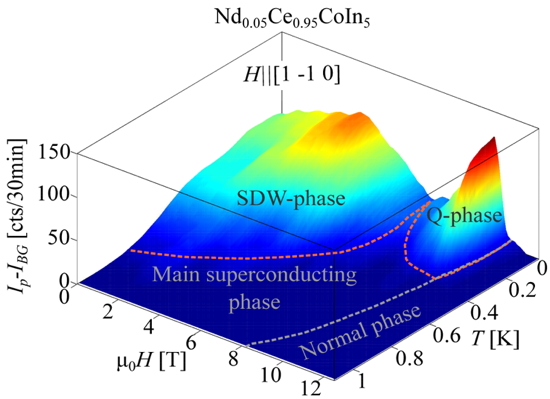A phase transition corresponds to a change of state of matter that is driven by thermal or quantum fluctuations. These fluctuations destabilize one phase in favor of a distinct one having a different organization principle. Textbook examples are the liquid-solid, the paramagnetic-ferromagnetic or the metal-insulator transition. It therefore came as a big surprise to evidence a transition between two identical magnetic phases in the superconductor CeCoIn
5 under magnetic field.
CeCoIn
5 is a model system where magnetism can be assisted by superconductivity. By substituting a small amount of Nd impurities (5%) on the Ce site, a magnetic ordering occurs inside the superconducting phase. This order corresponds to an antiferromagnetic-like arrangement forming a wave of ordered magnetic moments named a spin density wave. We have investigated the behavior of this phase under an applied magnetic field by neutron diffraction experiments performed at the Institut Laue Langevin, Grenoble, France and the Paul Scherrer Institut, Villigen, Switzerland in a collaboration between CEA-Grenoble and PSI. A field of 8 T suppresses the spin density wave, a phenomenon expected since the antiferromagnetic energy competes with the Zeeman energy imposed by the applied magnetic field. However surprisingly, the magnetic orders reappears at the same field of 8 T forming again the exact same spin density wave. Since such an instability cannot be magnetically driven, we conclude that there should be a change of the superconducting properties under magnetic field, namely a change of symmetry of the electronic Cooper pairs wave-function. Finally, the magnetic order disappears together with superconductivity at 11 T.
This result will trigger theoretical and experimental works since it challenges our understanding of matter through a unique intertwining of magnetic and superconducting orders.

Neutron diffraction intensity as a function of magnetic field and temperature for 5%-Nd substituted CeCoIn5: A phase transition at 8 T separates two antiferromagnetic phases with identical magnetic symmetry within a superconducting phase.